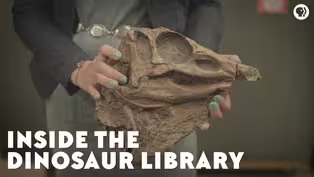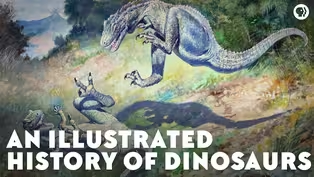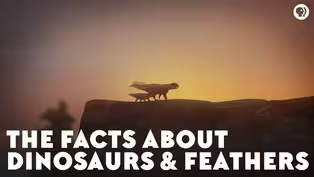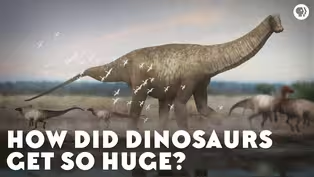
The Weird, Watery Tale of Spinosaurus
Season 1 Episode 41 | 7m 28sVideo has Closed Captions
In 1912, a fossil collector discovered the world’s only known semi-aquatic dinosaur.
In 1912, a fossil collector discovered some strange bone fragments in the eerie, beautiful Cretaceous Bahariya rock formation of Egypt. Eventually, that handful of fossil fragments would reveal to scientists one of the strangest dinosaurs that ever existed -- the world’s only known semi-aquatic dinosaur.
Problems playing video? | Closed Captioning Feedback
Problems playing video? | Closed Captioning Feedback

The Weird, Watery Tale of Spinosaurus
Season 1 Episode 41 | 7m 28sVideo has Closed Captions
In 1912, a fossil collector discovered some strange bone fragments in the eerie, beautiful Cretaceous Bahariya rock formation of Egypt. Eventually, that handful of fossil fragments would reveal to scientists one of the strangest dinosaurs that ever existed -- the world’s only known semi-aquatic dinosaur.
Problems playing video? | Closed Captioning Feedback
How to Watch Eons
Eons is available to stream on pbs.org and the free PBS App, available on iPhone, Apple TV, Android TV, Android smartphones, Amazon Fire TV, Amazon Fire Tablet, Roku, Samsung Smart TV, and Vizio.

Welcome to Eons!
Join hosts Michelle Barboza-Ramirez, Kallie Moore, and Blake de Pastino as they take you on a journey through the history of life on Earth. From the dawn of life in the Archaean Eon through the Mesozoic Era — the so-called “Age of Dinosaurs” -- right up to the end of the most recent Ice Age.Providing Support for PBS.org
Learn Moreabout PBS online sponsorshipMore from This Collection
Video has Closed Captions
Tyrannosaurus rex had tiny arms. How did this happen, and why did it keep them? (6m 54s)
Video has Closed Captions
We talk to Amy Atwater, Collections Manager at the Museum of the Rockies. (7m 19s)
An Illustrated History of Dinosaurs
Video has Closed Captions
Our image of dinosaurs has been constantly changing since naturalists started studying the (12m 20s)
The Facts About Dinosaurs & Feathers
Video has Closed Captions
Dinosaurs have been found with some sort of fluff or even full-on plumage. (10m 1s)
Living Fossils' Aren't Really a Thing
Video has Closed Captions
Even the most ancient-looking organisms show us that evolution is always at work. (5m 5s)
How Did Dinosaurs Get So Huge?
Video has Closed Captions
Creatures as tall as a five-story buildings shook the Earth. (5m 42s)
Video has Closed Captions
We know a lot about dinosaurs but there’s one question that has plagued paleontologists.. (5m 2s)
Stegosaurs: Tiny Brains & Thagomizers
Video has Closed Captions
If you take it as a given that extinct dinosaurs were all weird and wonderful, then you go (4m 49s)
Providing Support for PBS.org
Learn Moreabout PBS online sponsorshipIn 1912, a fossil collector discovered some strange beautiful fragments in the eerie, beautiful Cretaceous Bahariya rock formation of Egypt.
The fragments looked like they belonged to some kind of predatory dinosaur, but it was unlike anything experts had ever seen.
It was later described, in 1915, by a paleontologist with the awesome name of Ernst Freiherr Stromer von Reichenbach.
Stromer named the new dinosaur Spinosaurus aegyptiacus, Latin for "Egyptian spine lizard."
And for a long time, that name was the only information you could find about Spinosaurus.
It took nearly a hundred years for scientists to even begin to figure out what this animal really was, how it looked, and why it lived the way it did.
But eventually, that handful of fossil fragments would reveal to scientists one of the strangest dinosaurs that ever existed -- the world's only known semi-aquatic dinosaur.
When Stromer first described Spinosaurus, he didn't have much to go on -- just a handful of vertebrae, several giant dorsal spines, a lower jaw fragment, and some teeth.
Clearly, this thing was big, rivalling the biggest predatory dinosaurs ever found at the time.
But beyond that, all Stromer could determine was that it was some kind of theropod, and it was... different.
For instance, there were those huge spines, the longest reaching up to two meters in length.
At first, Stromer thought they might have supported a fatty hump like in a modern-day bison.
But he later concluded that they were more likely part of a giant sail, which proved to be the more popular interpretation.
But why a predator might need a giant sail on its back, he didn't know.
The jaw was also weird The shape of the lower jaw fragment seemed to indicate that Spinosaurus had a longer, narrower snout than most theropods.
The snout squared off at the end, and contained long, cone-shaped teeth instead of the short, serrated ones that other carnivorous theropods usually had.
It wasn't until 1936 that Stromer published a reconstruction of what he thought Spinosaurus looked like.
And his rendering resembled, basically, a T. rex with big forelimbs and a sail on its back.
It was really awkward looking, but accurate or not, Stromer's version of the dinosaur became the popular, accepted vision of Spinosaurus.
And soon, it became the only version.
Because, in 1944, Allied forces bombed the museum in Munich where the Spinosaurus fossils were held, and the specimen was destroyed.
Suddenly, Stromer's descriptions and a few photos of the fragments were the world's only records of this bizarre creature.
As time went on, other researchers tried to develop a more complete picture of Spinosaurus, but their work was all still based on the same old evidence.
It wasn't until the late 20th century that the idea began to take shape that Spinosaurus was a dinosaur with a truly unique lifestyle.
Because, during that time, new fossils were discovered in Africa, Europe, and South America that shared some similarities with Spinosaurus.
For example, a theropod called Baryonyx walkeri was described in 1986 by a pair of British researchers who noticed that it, too, had an elongated jaw with conical teeth - not unlike the lower jaw fragment described by Stromer all those years ago.
Because of its long snout, plentiful teeth, and some fish teeth and scales that were found mixed in with its remains, the researchers suggested that Baryonyx might be the first-known piscivorous, or fish-eating, theropod.
Then in the 1990s, more species were uncovered with a similar, croc-like jaw.
One small specimen was described in 1996 from a single skull fragment found in Brazil.
Another was described from a more complete skeleton reported in Africa in 1998.
By that time, enough evidence of these odd creatures had turned up that scientists decided to assign them all to a single group.
Paleontologists added all of these narrow-snouted Cretaceous theropods to the family called Spinosauridae, after Stromer's Spinosaurus.
But during all this time, no new fossils of Spinosaurus itself had been found, except for a handful of bone fragments.
Then, it finally happened.
In 2008, paleontologist Nizar Ibrahim was working on his doctorate in Morocco when a local fossil collector approached him with a box of fossils.
One fossil in particular caught Ibrahim's eye - it looked like Stromer's illustration of a Spinosaurus spine.
Ibrahim convinced the man to lead him and his team to the original site of the fossils.
The collector took them to a cliffside in the Kem Kem fossil beds, and sure enough, it was a Spinosaurus treasure trove.
There they found both hind limbs, much of the pelvis, several neural spines, and a large portion of the lower jaw from what was likely a juvenile Spinosaurus.
The team took CT scans of the newly discovered fossils and created digital models based on Stromer's original descriptions.
Then, they put all the pieces together and published a paper announcing their findings in 2014.
Nearly 100 years after Stromer first described Spinosaurus, paleontologists got a fresh look at the famous dinosaur.
And it was even weirder than anyone thought possible.
For one thing, its nostrils were on the top of the snout.
And it also had evidence of croc-like pressure receptors on the tip of its snout.
Its limbs seemed suited to horizontal swimming, in addition to walking, and its bones were also more dense than other dinosaurs'.
All of these clues put together led Ibrahim and his colleagues to suggest that Spinosaurus actually spent at least part of its time in the water, making it the first-known semi-aquatic dinosaur of any kind.
As for the sail?
Paleontologists still can't agree on what it's for, but there have been some interesting ideas.
Some think it was used as a threat display or to attract mates, while others think it could have regulated the creature's body temperature.
A paper from 2016 suggests that it might even have functioned like the sail on a sailfish, helping Spinosaurus maneuver in the water or corral schools of fish.
So, Spinosaurus turned out to be totally unique and fascinating.
But of course, the question remains: Why?!
Why did this thing exist?
What sort of environmental pressures could produce a giant sail-backed, semi-aquatic dinosaur?
Well, northern Africa wasn't always a giant desert.
During the Cretaceous Period, it was home to a river that stretched from what's now Morocco all the way to Egypt.
Some researchers refer to this waterway as the "River of Giants," because it had an abundance of prey in the river and its surrounding tropical forests, as well as an unusually high density of big predators.
Aquatic reptiles, giant sawfish, and coelacanths the size of buses swam in this ancient river, while crocodiles sunned themselves on the shores.
And giant theropods like Carcharodontosaurus roamed nearby.
This kind of environment would have offered a lot of prey for Spinosaurus, but also a lot of fierce competition, both on land and in the water.
So, being able to take advantage of food sources in both places would have been a huge advantage.
By spending much of its time in the water, it could avoid direct competition with other large theropods, but it could also prey on land animals if it needed to.
The adaptations of Spinosaurus proved to be exquisitely useful, but nevertheless, as far as we know, they seem to be unique.
There's no fossil evidence of any other aquatic dinosaurs, semi- or otherwise.
But maybe there are others out there waiting to be found!
After all, Spinosaurus wasn't the only dinosaur that lived in a competitive environment.
Until we find more like it, however, Spinosaurus will remain a truly distinctive character in the history of our planet -- one of the most unique and fascinating apex predators the world has ever seen.


- Science and Nature

A documentary series capturing the resilient work of female land stewards across the United States.












Support for PBS provided by:









